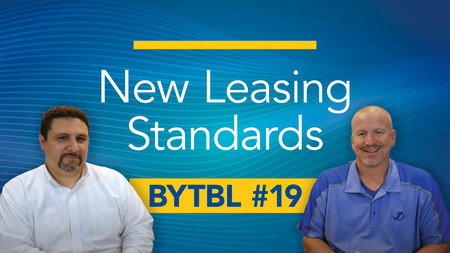Transcript
Mike Helton:
Hi, my name is Mike Helton and I’m a tax shareholder here at Rivero, Gordimer & Company.
Chris Terrigino:
I’m Chris Terrigino, and I’m an audit shareholder at Rivero Gordimer & Company.
Mike Helton:
So, if you’re watching this, you may be a subscriber to our YouTube channel Beyond The Bottom Line. You might be watching this through our Facebook, Twitter, or LinkedIn as well. Chris, today as a tax shareholder, I came across some information on our website. You wrote an article back in July, I think of last year, about new lease standards. And as a tax person, I was sort of caught off guard saying: “what is this?” and “who’s this applied to?” I know we ended up this past busy season dealing with that on some matters with some clients, but as an uneducated tax person, I’m trying to figure out what other clients this might apply to. So, tell me a little bit about what drew you to want to write the article. Also, we’ve got a section there for articles. If you drill into business advice and just do a search for lease, you can find this article and it pulls up and it looks like a rent-to-own contract. So, does it just apply to RTO businesses in general or is this open to many others?
Chris Terrigino:
Mike, this will apply to basically all organizations that lease property. This change came about a few years ago, and now it is enforced at the beginning of 2022 for all companies where they basically need to look at their leases and capitalize or put them on the balance sheet as a right-to-use asset and liability, basically lease liability.
Mike Helton:
Okay. I’ve got to ask some questions cause now you’re talking above my head. So, you said ‘right of use.’ So, let’s just say I’m a great local bakery, La Segunda, you know, was awesome. Best Cuban sandwiches in town, by the way. But let’s say I’m La Segunda. I don’t do GAP financials. I don’t do an audit. I just hire Rivero, Gordimer and Company. I keep a set of QuickBooks. Do I need to worry about this kind of stuff?
Chris Terrigino:
Not at all. If you are not producing GAP financial statements, you most likely don’t need to worry about it, but keep in mind, your bank might want to see GAP-style financial statements, and you look at your loan covenants. So always check that out and you might be able to get a waiver from the bank on that, because honestly, they might not care about it either.
Mike Helton:
Okay. So, if I’m not hiring us to do a review or an audited financial, but I still want to keep GAP-level financial statements, this is still something that I need to be inquiring about?
Chris Terrigino:
Yes. It’s something to check into. It’s not hard after the initial implementation of it. And just updating it is basically amortizing a way like you would any other fixed asset.
Mike Helton:
Okay. So, you mentioned right-of-use assets. So, this is going to be a new asset and a new liability on my balance sheet?
Chris Terrigino:
Yes, absolutely. You’re going to have a new line item for a right-to-use asset. And you actually will split that if you have operating or financing leases, which is just two different variations of a lease that don’t matter much right now, Mike, but it’s just the thought that you’re going to see a separate line item. You’re going to see a separate liability, a new liability, a new asset.
Mike Helton:
Does it impact my bottom line at all?
Chris Terrigino:
It will change the bottom line a little bit, but not a true change. The cash is king. The cash out the door is not changing because of a new accounting standard. It’s just going to be the way it’s presented between rent expense and either interest or amortization expense. Before you paid rent, you wrote rent expense, and you were done. There’s going to be a slight change there, which could affect some of the, again, we come back to the debt covenants, the way you look at your EBITDA, things like that. But overall, the cash number isn’t going to shift.
Mike Helton:
So, if I haven’t done this yet, can I do some kind of a catch up AJE journal entry?
Chris Terrigino:
Yes, one thing they did is you don’t need to go back to the beginning of the time. You could basically incorporate it as of the beginning of the year and just catch up with all your leases and bring it to that date and go forward. Otherwise, it could be overly cumbersome to go keep looking back.
Mike Helton:
So, if I’ve looked at this video, I’ve spent two minutes and I say, oh, this might apply to me, who can I call? Obviously, I want to go back and read the article, but who can I call at our firm to get more information?
Chris Terrigino:
Yeah, you could call me, you could call any one of our auditors here. We have to be prepared to deal with this. We’re talking to our clients and even potential clients saying, “Are you aware of this? Are you incorporating the changes now?” It’s very easy for one or two leases. Obviously when you get to much larger companies with multiple leases, 100 leases, 200 leases, store leases, or other types, you’re going to need to analyze each one of those, and you might want to look at buying specific software.
Mike Helton:
This applies to vehicle leases too, not just land leases or operational store retail leases.
Chris Terrigino:
Yes. It applies all leases. But I want to talk about some exceptions really quick, Mike. One, if a lease is less than 12 months, you do not need to apply the standards. If it’s below your standard capitalization policy; normally you expense items that are under $5,000, you could apply the same standard here. The lease cost total wouldn’t be over $5,000. You could expense that as normal and the last one area generally deals with related parties. There could be exceptions there also because basically a lease is a conveyance of a right when you own both sides of it. You’re not giving up anything.
Mike Helton:
So, my operating store leases to my LLC that I own as well. There are exceptions there?
Chris Terrigino:
You can have an exception there if you want.
Mike Helton:
So, is there any more information we’re going to put out on this? Like a webinar or anything of that nature? More detailed.
Chris Terrigino:
We have this nice article as a good primer. We’re going to put together a detailed transactional application of this looking at a lease: what are the actual entries that need to be made on your books to be posted to your general ledger, which will in turn end up on your financial statements.
Mike Helton:
Are we going to hand out RedBull to everybody that attends that?
Chris Terrigino:
Oh, it’s going to be exciting. We’re going to focus on the standard normal store type leases generally. That’s what the majority of people are going to have. The facility they use, that’s the lease. We don’t want to overcomplicate it. With everything there’s always a multitude of exceptions or other types of contracts that come into play. If you need help with those, especially, we’re here to help you. We want to make it very simple for people to do it themselves because you’ll be better off understanding it yourselves.
Mike Helton:
Good information Chris. Thank you for your time. And thank you for following us on Beyond the Bottom Line. Have a good day.




